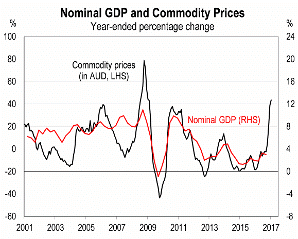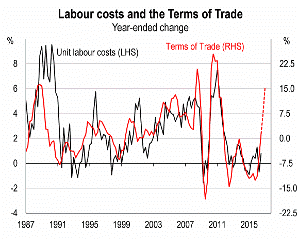Will households feel the tailwind of rising commodity prices?: Paul Bloxham
GUEST OBSERVER
The tailwind is here. Higher commodity prices are boosting national incomes and the numbers are large.
Export values rose by a strong 32% year-on-year in December which drove the largest trade surplus on record. This is driving a strong rise in mining profits and tax revenues. The debate is about whether the lift in mining profits and taxes will boost wages growth, household spending and domestic inflation, as it has done in the past.
Will households feel the tailwind too? Some observers argue that without another mining investment boom or the government delivering personal tax cuts, both of which, we agree, seem unlikely, a rise in domestic wages and inflation will not happen. In our view, scale is important here. Although we agree that the income effect on households is likely to be less potent than in the past, some of the effect should still get through. Plus, this boost is in addition to the services sector growth story which is still humming along. We think this will keep the RBA from cutting further and expect that these same forces could mean rate hikes in 2018.
As we have been pointing out for some time now, we see the recent lift in commodity prices as having changed the economic story for Australia. For the past five years, Australia has sought to pull off a 'great rebalancing act' and this year with think that the rebalancing act is almost done. This is largely because the significant headwind that Australia has faced over the past five years, as a result of falling commodity prices and mining investment, is now becoming a noticeable tailwind. The resources sector is set to become a contributor, rather than a drag, on growth.
The past couple of weeks have revealed more evidence that the boost to incomes from higher commodity prices has already arrived. Export values rose by a strong 32% year-on-year in December, supported by a 127% rise in the value of coal exports. This drove a significant swing in the trade balance, from a deficit in October to the largest trade surplus in the history of the available numbers (since 1971) in December. Although we do not yet have the Q4 GDP figures, as chart 1 below shows, there is a strong positive correlation between commodity prices and Australia's nominal GDP growth. As a result, the RBA has been confident enough to recently state that higher commodity prices 'are providing a boost to Australia's national income'.

As the income has already arrived, the question is not whether there will be a pick-up in incomes, but whether it will flow through to the household sector, to wages and domestic inflation, as it has done in the past? On this, some observers argue that without another mining investment boom or boost to household incomes from personal tax cuts, both of which seem unlikely, a rise in domestic wages and inflation is unlikely.
We agree with some of these arguments, but think it is mostly a question of scale.
First, we agree that the pick-up in commodity prices is unlikely to stoke a substantial upswing in mining investment anytime soon. But we are not as convinced that this means you will not see any flow through to households. Keep in mind that mining investment is already set to stop falling from around mid-2017, as the resources sector shifts from new construction to maintenance and repair, which is now a larger spend than it has been in the past. Mining employment has also already started to stabilise and the timely mining sector job vacancy indicators are lifting. Spending on mineral exploration has also levelled out recently, after years of decline. Given the considerable recent boost to mining profits it seems unlikely, in our view, that mining sector wages growth will continue to fall as much it has in recent years.
Second, we agree that the federal government is unlikely to deliver income tax cuts, as it did between 2003 and 2007 when the commodity price super-cycle was first in its upswing. However, the corporate tax take will be boosted, which should take some pressure off the Federal budget. Some of this is likely to show up in the public sector wage bill. State royalties will also be boosted in Western Australia and Queensland and we expect some of this to trickle into state spending and public sector wages.

Overall, our strongest argument is that the significant scale of the ramp up in commodity prices, exports and nominal incomes means that at least some of the pick-up is likely to get through to the household sector, wages growth and domestic inflation. Just a levelling out of mining sector activity and incomes, after five years of decline should be expected to help see wages and domestic inflation stabilise. What we have seen is much more than this, with national income significantly boosted (again, see chart 1). Add to this that the non-mining economy has already been growing solidly, supported by low interest rates, the lower AUD and rising demand for services from Asia's growing middle classes.
Finally, it is worth keeping in mind that recent history supports the view that a lift in commodity prices should drive a pick-up in wages growth and inflation. As chart 2 shows, there is strong positive historical correlation between the terms of trade (think commodity prices) and unit labour costs (think wages). Given the scale of the ramp up in the terms of trade it would be surprising if unit labour costs did not lift at all. In turn, rising unit labour costs should be enough to support a modest lift in domestic inflation. In our view, the RBA only needs to be convinced that underlying inflation is past its trough to keep them from cutting. With this, we expect the RBA to be on hold through 2017 and to lift its cash rate in 2018.
Paul Bloxham is chief economist, Australia, New Zealand of HSBC.
